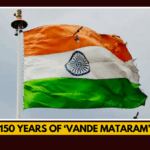India’s national song, Vande Mataram, celebrates its 150th anniversary this year. Written by Bankim Chandra Chatterjee, the song became a symbol of India’s freedom struggle and continues to evoke national pride across generations.
First published on 7 November 1875 in the literary journal Bangadarshan, Vande Mataram later appeared in Chatterjee’s novel Anandamath (1882). The song, meaning ‘Mother, I Bow to Thee,’ was set to music by Rabindranath Tagore, helping it gain popularity nationwide. Over the decades, it has inspired patriots, activists, and cultural movements, becoming a rallying cry during India’s freedom struggle.
10 Key Facts About Vande Mataram
First published on 7 November 1875 in Bangadarshan.
Written by Bankim Chandra Chatterjee and later included in his novel Anandamath (1882).
Literal meaning: ‘Mother, I Bow to Thee.’
Music composed by Rabindranath Tagore, which popularized it across India.
Became a rallying cry in protests and patriotic events during the freedom struggle.
In 1905, the Bande Mataram Sampradaya was founded in Kolkata to promote the hymn as a mission of patriotic devotion.
British authorities attempted to suppress the song, punishing students and activists who chanted it.
Formally recognized by the Constituent Assembly in 1950, alongside the national anthem Jana Gana Mana.
Inspired cultural works, music, and political movements across India.
Continues to symbolize national pride, unity, and India’s struggle for independence.
Vande Mataram’s Role in India’s Freedom Movement
In August 1906, an English-language daily titled Bande Mataram was launched under the editorship of Bipin Chandra Pal, with Sri Aurobindo later joining as joint editor. The newspaper, through incisive editorials, became a powerful instrument of India’s awakening, promoting self-reliance, unity, and political consciousness.
The growing influence of Vande Mataram – both as a song and a slogan – alarmed the British administration, prompting strict measures to curb its spread. In November 1905, 200 students at a school in Rangpur, Bengal, were fined ₹5 each for chanting the song. Anti-partition leaders in Rangpur were also instructed to act as special constables to prevent its use.
Despite restrictions, the song continued to inspire patriotic fervor. In November 1906, a large gathering in Dhulia, Maharashtra, erupted in cries of Vande Mataram. In 1907, Bhikaji Cama raised the tricolour flag outside India for the first time in Stuttgart, Berlin, inscribing the words Vande Mataram on it. In 1908, in Belgaum, Karnataka, police reportedly beat and arrested several individuals, including students, for chanting the song in defiance of a ban on the day Lokmanya Tilak was deported to Mandalay.
National Recognition
On 24 January 1950, Dr Rajendra Prasad addressed the Constituent Assembly, emphasizing Vande Mataram’s pivotal role in India’s freedom movement. He recommended that it be accorded the same status as the national anthem, Jana Gana Mana, and be equally honoured. Following his recommendation, Tagore’s Jana Gana Mana was adopted as India’s national anthem, while Chatterjee’s Vande Mataram was designated as the national song, holding equal significance alongside the anthem.







